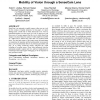Free Online Productivity Tools
i2Speak
i2Symbol
i2OCR
iTex2Img
iWeb2Print
iWeb2Shot
i2Type
iPdf2Split
iPdf2Merge
i2Bopomofo
i2Arabic
i2Style
i2Image
i2PDF
iLatex2Rtf
Sci2ools
MHCI
2009
Springer
2009
Springer
Fixed in time and "time in motion": mobility of vision through a SenseCam lens
SenseCam is an automatic wearable camera, often seen as a tool for the creation of digital memories. In this paper, we report findings from a field trial in which SenseCams were worn by household members over the course of a week. In interviews with these users, it became apparent that the way in which SenseCam images were played back, the manner of which might be described as a stilted movie, affected the values that were realised within them. The time-lapse nature of the image stream led participants to romanticise the mundane and find sentimentality in unexpected places, and was particularly effective at portraying personality and play. In so doing, SenseCam images enlivened the visual recording of everyday scenes. These values influenced what the participants sought to capture and view, and have implications for technologies that might support lifelogging or the development of user-generated content. Categories and Subject Descriptors H.5.m [Information Systems]: Information Inter...
Automatic Wearable Camera | Human Computer Interaction | MHCI 2009 | SenseCam Images | User-generated Content |
| Added | 27 May 2010 |
| Updated | 27 May 2010 |
| Type | Conference |
| Year | 2009 |
| Where | MHCI |
| Authors | Siân E. Lindley, Richard H. R. Harper, David W. Randall, Maxine Glancy, Nicola Smyth |
Comments (0)

